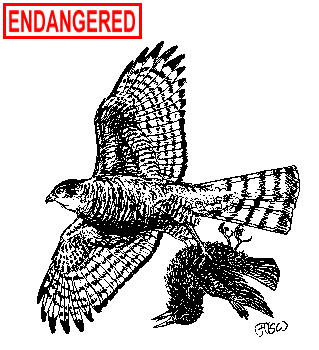Sharp-shinned Hawk
Accipiter striatus

Habitat: Large, remote, young forests.
Weight: Males, 3-4 ounces; females, 6-8 ounces.
Length: 10-14 inches.
Wingspan: 20-27 inches.
Life Expectancy: Records are scarce. One banded bird lived to be 12 years of age.
Food: Small birds; occasionally mice, shrews, bats, frogs and insects.
Status: State endangered.
Identification: The slender, long-bodied sharp-shinned hawk has short, rounded wings and a long, narrow tail. The adult has a dark, blue-gray back and a rusty-barred breast; immature hawks have more brown, with streaking on the underparts. The sexes are similar in appearance, but the female is about one-third larger than the male. Like all accipiters (a genus of small hawks with short wings and long tails), the sharp-shinned flies with several quick wing beats and a glide. The species is easily confused with the Cooper’s hawk, although it is much smaller. Whereas the tail of the Cooper’s hawk is well rounded, the tail of the sharp-shinned hawk is nearly square or slightly forked and the tip is not sharply defined, appearing dirty gray.
Range: Sharp-shinned hawks occur throughout most of North America, from Alaska and Canada south to the Gulf States. However, the species does occur throughout the breeding range in small numbers. In the fall, large numbers of sharp-shinned hawks pass through southern New England as they migrate to the southeastern United States and Central America for the winter.
Reproduction: The breeding season for sharp-shinned hawks is in April and May. A new nest is usually built every year, although the same nesting area may be used for several years. Preferred nesting sites in Connecticut are in young, mixed coniferous/deciduous forests. The nest, built of sticks or twigs and lined with strips of bark, is typically about 2 feet wide. It is well hidden, usually in a stand of conifers, against a tree trunk in a crotch or on a major branch. Generally placed 30 to 35 feet above ground, the nest can be recognized as a broad, rather flat platform of sticks. The 4 to 5 well-rounded eggs are dull white and spotted with varying shades of brown. Incubation, shared by both male and female, takes 34 to 35 days. The young first fly when they are about 23 days old.
Reason for Decline: Sharp-shinned hawk populations declined in the 1970s due to eggshell thinning caused by pesticide contamination in their prey. Although pesticides no longer play as large a role in the decline of sharp-shinned populations today, the species is still affected by other factors, like the loss of habitat. Collisions with plate glass doors and picture windows are responsible for the deaths of many sharp-shinned hawks annually. The glass reflects the surrounding woods and cannot be readily distinguished by a hawk chasing prey or seeking cover.
History in Connecticut: The sharp-shinned hawk is a common migrant from the end of the summer until early November in Connecticut. Some individuals stay in the state during the winter, frequently preying on smaller birds visiting nearby bird feeders. Except for migration counts, reliable population data for Connecticut are scarce. The sharp-shinned is listed as a threatened species in Connecticut due to its small breeding population in the state.
Interesting Facts: In the Northeast, the sharp-shinned hawk is the most common accipiter seen during migration. In Connecticut, sharp-shinned hawks are seldom seen except during fall migration, when they frequent open country, woodland edges and shorelines.
The hawks usually bring their prey to a feeding perch or log. Such logs, and the feathers, fur or animal parts near them, are characteristic of the territory of sharp-shinned hawks and other accipiters.
The sharp-shinned hawk is the smallest North American accipiter. Its short wings and body design allow it to capture other birds while flying through thick woodlands.
This hawk gets its name from its flattened, thin "shins" or shanks.
Protective Legislation: Federal - Migratory Bird Treaty Act of 1918. State - Connecticut General Statutes Sec. 26-311.
What You Can Do: Although seeing a sharp-shinned hawk at the winter bird feeder preying on favorite songbirds can be traumatic to some feeder watchers, individuals must understand and accept this bird’s role in the food chain. Sharp-shinned hawks occur in lower numbers, produce fewer young and breed less often than the songbirds seen at feeders.
Conservation of large blocks of forested habitat will help provide suitable nesting areas for sharp-shinned hawks. The regulated use of pesticides will help prevent a recurring problem with eggshell thinning and birth defects. Placing silhouettes in windows, or drawing shades or curtains, should minimize bird/glass impacts.
Since woodland nesting species such as the sharp-shinned hawk are often difficult to survey and monitor, any confirmed nests should be reported to the Wildlife Division to help increase our knowledge of the activities of these birds in Connecticut.

The production of this Endangered and Threatened Species Fact Sheet
Series is made possible by donations to the Endangered Species/Wildlife Income Tax
Checkoff Fund.
(rev. 12/99)

